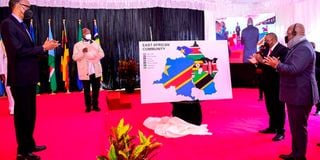Uhuru Kenyatta's scorecard at the helm of EAC

Some of the East African Heads of State (L-R) Paul Kagame of Rwanda, Yoweri Museveni of Uganda , Uhuru Kenyatta of Kenya and Felix Tshisekedi of DRC looking at a placard showing the new map of the East Africa region after the signing ceremony of the treaty of accession by the DRC in Nairobi, Kenya on 8th April 2022.
What you need to know:
- The region views him as the president who expanded the EAC membership by overseeing the admission of the Democratic Republic of Congo, oversaw the region’s recovery from effects of the Covid-19 pandemic and fixed the Kenya-Tanzania trade disputes.
- But critics also point to ever-emerging non-trade barriers; trade disputes between Uganda and Kenya; elusive peace in Eastern DR Congo and poor Uganda-Rwanda relations.
With the clock ticking towards President Uhuru Kenyatta’s exit as the East African Community Summit chairperson this May, opinion is divided on his legacy.
The region views him as the president who expanded the EAC membership by overseeing the admission of the Democratic Republic of Congo, oversaw the region’s recovery from effects of the Covid-19 pandemic and fixed the Kenya-Tanzania trade disputes.
But critics also point to ever-emerging non-trade barriers; trade disputes between Uganda and Kenya; elusive peace in Eastern DR Congo and poor Uganda-Rwanda relations.
President Kenyatta took over the chairmanship of the EAC in February 2021 from Rwanda’s Paul Kagame at a time the world was facing a global health pandemic.
His term comes to an end this May, three months to Kenya’s General Election.
He is expected to hand over the chairmanship to Burundi’s Evariste Ndayishimiye.
“President Kenyatta came at a very difficult time, during the Covid-19 pandemic. As the umbrella body of the private sector in the region, we appreciate his role in ensuring cross-border trade continued despite the Covid-19 travel protocols that inhibited trade,” said John Kalisa, chief executive of the East African Business Council.
“He co-ordinated the Covid-19 response. The region was able to safeguard against the shortage of essential goods and services.”
Under President Kenyatta’s leadership, five EAC states – excluding South Sudan – have ratified the African Continental Free Trade Area (AfCFTA). “EAC has attained a 90 percent tariff offer that is required to trade under the AfCFTA. That is a great achievement under his leadership,” said Mr Kalisa.
But it is the admission of the DRC into the bloc that won President Kenyatta most applause from the private sector and the secretariat.
“He fast tracked the admission of the DRC into the EAC. This is very important for the region because DRC has the largest consumer market in the region today,” said Mr Kalisa.
DRC is endowed with exceptional natural resources, including minerals such as cobalt and copper, hydro-power potential, significant arable land, immense biodiversity, and the world’s second-largest rainforest.
The DRC applied to join the EAC in 2018 and formally joined the bloc on April 8, when President Felix Tshisekedi signed the deed of Accession to the Treaty establishing the EAC.
Its admission offers a combined market-driven economy of 266 million people and a gross domestic product of $243 billion for the region.
“The DRC, which has the potential to open the Indian Ocean to the Atlantic Trade Corridor and link the region to north Africa, central Africa and other continental sub-regions,” said Dr Kevit Desai, the principal secretary at the Ministry of EAC and Regional Development.
Despite this, the region has adopted a wait-and-see attitude in regards to the elusive peace in the eastern DRC. President Kenyatta recently chaired the DRC Conclave aimed at restoring peace.
The DRC has accused some of its neighbours of being sympathetic to a section of rebels in the Eastern part of the country.
During a meeting held last month in Nairobi, President Tshisekedi asked his EAC counterparts to assist in taming the rebels.
NTBs
The private sector and the East African Legislative Assembly (Eala) fault President Kenyatta for the slow resolution of non-tariff barriers in the bloc.
“We expected that the Trade Remedies Committee would be in place to assist resolve trade disputes among members. That is yet to take place. The NTB Act has also been lacking for so long,” said Mr Kalisa.
Under the Customs Union Protocol, the Trade Remedies Committee is to handle matters dealing with rules of origin, ensure regulations on anti-dumping measures are adhered to and deal with safeguard measures.
But the committee, which is also expected to look into subsidies and countervailing measures, is not yet in place 10 years since it was proposed for enactment.
“The delay to ratify the amendment by partner states 10 years later was regrettable,” said Hon Marie Claire Burukikiye of Eala.
Critics also say that though President Kenyatta has resolved the historical border trade disputes between Kenya and Tanzania, which has seen trade volumes between the two countries increase, he has not been enthusiastic about the Rwanda-Burundi and Rwanda-Uganda rows.
Also, a trade dispute with Uganda over sugar, milk and poultry products imports into Kenya has been simmering for more than three years now.
“The trade war between Kenya and Uganda has affected Ugandan products to other regions,” said Simon Kaheru, chairperson of EABC Uganda chapter.
“Industrial sugar has a large market within the East African region…Uganda has a surplus but it cannot sell to Kenya, Rwanda or Tanzanian companies because of protectionism.”
President Uhuru has also been criticised for the manner he has handled the standard gauge railway inland terminal in Suswa, Kenya.





